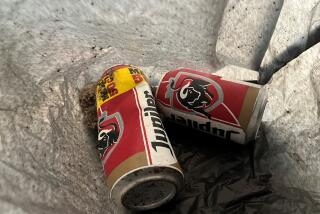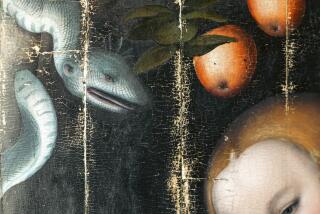Can This ‘Marriage’ Be Saved? : Louvre Mishap Is Latest Disaster to Befall Veronese’s Renaissance Masterpiece
PARIS — In its four centuries of existence, Veronese’s giant Italian Renaissance painting “Marriage at Cana” has endured plenty of abuse, even before the tragic episode at the Louvre Museum here last month, when museum engineers dropped the 1.6-ton masterpiece during rehanging and ripped several holes in the canvas.
After its completion in 1563, for example, the painting--which depicts the biblical wedding feast at which Jesus Christ turns water into wine--was nailed to the wall of its original home, the Benedictine Abbey San Giorgio Maggiore in Venice. Artist Veronese even painted flaps in the canvas to hide the nails.
In 1797, it was ripped off the monastery wall, rolled up and transported to Paris by Napoleon’s agents after his Italian campaign. In Paris, in 1798, the canvas was split in half, horizontally, so it could be hung in two pieces.
During the 1870 Franco-Prussian War, the painting, by then the property of the Louvre, was rolled up and taken to the western French port of Brest for protection.
During World War II, it again was rolled up and furtively moved between several chateaux in Vichy, France. In this case, the French were not so much worried about the German occupiers as they were about the Germans’ Axis power Italian allies, who they feared might be in the mood to reclaim their lost treasure.
Sometime after World War II, the painting suffered a gash more than a yard long and eight inches wide along its left border when a support cylinder collapsed.
The accident was similar, though less serious, to the June 3 mishap in which Louvre engineers miscalculated the large work’s center of gravity during a rehanging operation, causing two iron supports to twist violently, break and rupture the canvas.
Nathalie Volle, the museum expert in charge of the painstaking repair, said the painting should be restored to its original state with no visible scars.
But chagrined Louvre officials fear the highly publicized accident will take the shine off what they consider one of the museum’s greatest successes: a three-year, $1-million effort to clean the canvas and restore its original brilliant colors.
As with the cleaning of Michelangelo’s murals in the Sistine Chapel in Rome, the restoration of “Marriage at Cana” has sparked both praise and controversy.
Using X-rays and sophisticated chemical analysis, museum experts have restored the brilliant turquoise-blue sky in the painting’s background, revealed unknown detail hidden by centuries of grime and even aided in the identification of some of the “celebrity” characters painted by Veronese into the work.
In keeping with a Renaissance tradition, the artist included contemporary figures--including fellow artists Titian and Tintoretto, and himself in self-portrait--among the 120 human characters in the work. According to officials, the cleaning has helped definitively identify these and other characters.
The restored painting, revived to include such fine details as the pattern on the blouse of the young bride, was supposed to be unveiled at the Louvre in a special exhibition beginning in September. But because of the accident it has been delayed until November.
French museum officials have refused most journalists’ requests to see the damaged painting.
But Corinne Delpuech, a reporter with Agence France-Presse, was granted permission to view the work for a few minutes on July 11, as rumors circulated wildly in the French art community about the extent of the damage. Delpuech reported for her news agency that the painting “had not suffered damages as dramatic as described in some of the most persistent rumors.”
The work, measuring nearly 753 square feet (70 square meters), had already been the center of a controversy stirred up by a small Parisian group of artists, the Assn. to Protect the Integrity of Artistic Heritage. The group, led by Parisian artist Jean Bazaine, has been critical of the Louvre management, which they said had not taken proper care of the masterpiece during what they called “a cleaning frenzy” to restore it.
Along with the “Mona Lisa” by Leonardo da Vinci, with which it is usually displayed, “Marriage at Cana” is considered one of the finest examples of Italian Renaissance art at the national museum.
Besides the harm caused by the June 3 fall, the painting suffered serious water damage during a severe June 1 rainstorm, including the “disappearance” of a small dog, depicted running in the foreground of the painting, critics of the museum claimed.
But journalist Delpuech happily reported after seeing the painting that “the little dog still trots about among the dishes.”
In an interview with The Times, Volle, chief of restoration of paintings for French national museums, dismissed accounts of severe water damage, claiming the painting had been only lightly splattered in one small area at the bottom of the frame by water falling from a leaking overhead cooling system.
Damage from the June 3 fall, she said, consisted of three major slashes, each about one meter (39 inches) in length in the lower right central area of the painting and one equally long indentation of the left central foreground.
“Honestly,” said Volle, “the damage is not really that bad considering the size of the painting. Actually, we were lucky about the location of the cuts. It would have been a disaster if it had touched the sky (center background of the painting) because the paint is so thin there.”
Today, the painting lies flat on its face in the Salle des Etats of the Louvre as a team of restorers, working like surgeons, attempt to resew the ripped canvas “thread by thread.” The entry to the Salle des Etats is sealed and locked. Only a handful of museum officials are permitted entry.
DAMAGE CONTROL
The monumental masterpiece by Veronese, “Marriage at Cana,” sustained damage in five places when the 22 x 32 1/2-foot painting fell during its rehanging June 3. Museum officials say restoration of the work, painted in 1563, will remove most traces of the damage.
Key to damage:
1. Deep indentation caused by support pillar
2,3,4. 39-inch slashes caused by broken support poles
5. Water damage during a June 1 rainstorm
Source: Louvre
More to Read
The biggest entertainment stories
Get our big stories about Hollywood, film, television, music, arts, culture and more right in your inbox as soon as they publish.
You may occasionally receive promotional content from the Los Angeles Times.










